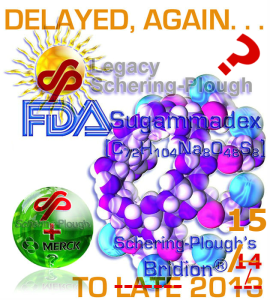 As we last noted around St. Paddy's 2015 -- sugammadex (a former 2008-09 "Fast Fred" Five Stars candidate) has been repeatedly left at the altar, by FDA staffers and the associated Advisory Committees. That is probably wise, in my estimation. [It is however approved -- and on sale in a handful of countries around the world -- as Bridion®.]
As we last noted around St. Paddy's 2015 -- sugammadex (a former 2008-09 "Fast Fred" Five Stars candidate) has been repeatedly left at the altar, by FDA staffers and the associated Advisory Committees. That is probably wise, in my estimation. [It is however approved -- and on sale in a handful of countries around the world -- as Bridion®.]
The latest? Today, Matt Herper re-ignited the engines -- on calls to require companies to disclose precisely why FDA repeatedly bounces certain drug candidates. He offers great analysis of a new British Medical Journal study -- one that lays bare how far off the mark most companies are, when describing the "why" behind repeated "complete response letters" (that's the modern term for a rejection letter, at FDA). Here's a bit -- do go read all of Matt's fine writing:
. . . .Current FDA regulation means that the agency does not publish its rejection letters, known as complete response letters. But FDA researchers led by Peter Lurie, the Associate Commissioner for Public Health Strategy and Analysis at the FDA and a former researcher at the consumer gadfly group Public Citizen, found a clever way around this restriction. They broke up the complete response letters, resulting press releases, and filings to the Securities and Exchange Commission into discrete statements. Then, they counted how often the statements in the press releases (or, in a separate analysis, the SEC filing) matched what was actually in the rejection letter.
Twenty one percent, or 13, of the press releases did not contain any of the details from the letters. Press release statements matched only 93, or 14%, of the 687 statements about reasons for rejection contained in the complete response letters. This increased to 101, or 15%, when the analysis of SEC filings was concluded. . . .
And so -- the fate of Bridion may dribble now into 2016 -- and that's eight full years beyond Fred Hassan's "most conservative" predictions. Maybe it is just not such a great drug, afterall, on the safety vs. efficacy/perceived OR benefit, as a co-plotted dimensional x-y chart. Onward -- have a stellar weekend, one and all!

















2 comments:
While I agree with this, implementing a requirement that complete response letters be made public will not completely resolve the issue. I know this because I've seen complete response letters that have not included the primary reason why a drug was rejected by reviewers, which if communicated in a CR letter would likely kill the drug for good. When such reasons are not included it allows the company to pursue and obtain marketing approval overseas when the FDA actually thinks the drug is too dangerous to be used in the US.
ex-FDAer
I do hear you -- and thanks, for the experienced perspective -- quite valuable.
Being a securities lawyer, I believe the law already requires the companies to disclose all the material risks (including the "real" reasons for any FDA rejection) -- at least about any candidate that becomes material, to the company.
I think Matt is right -- when he implies that doesn't always happen.
But I think strict adherence to the '34 Act rules, for public pharma companies, would require it.
So... On we go!
Namaste -- do stop back!
Post a Comment